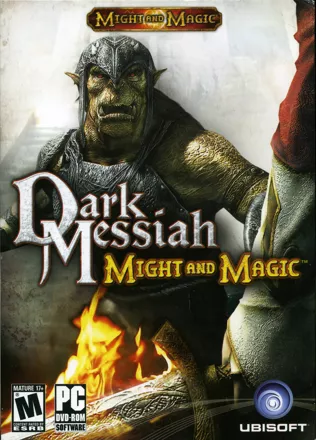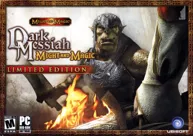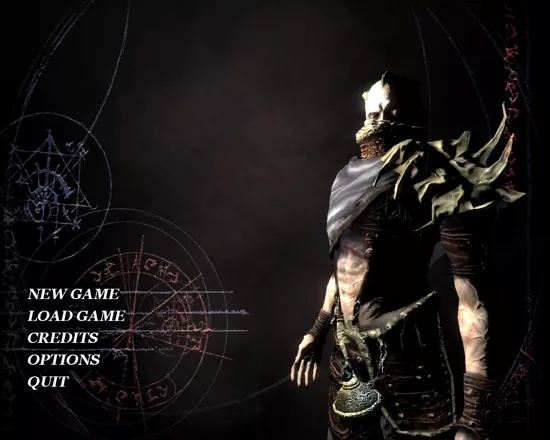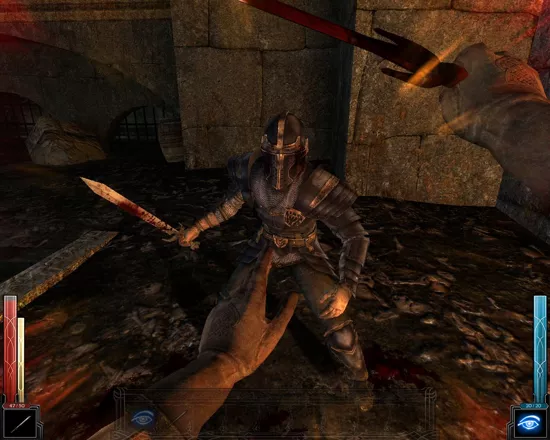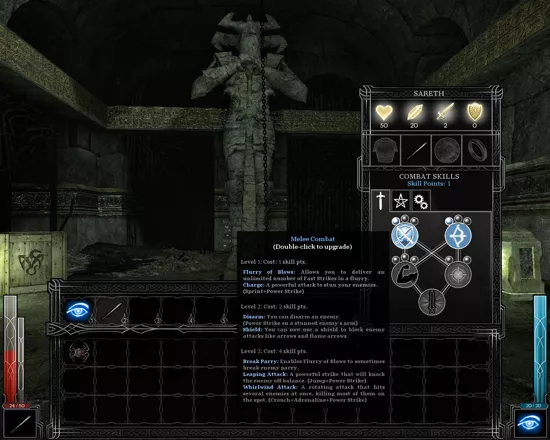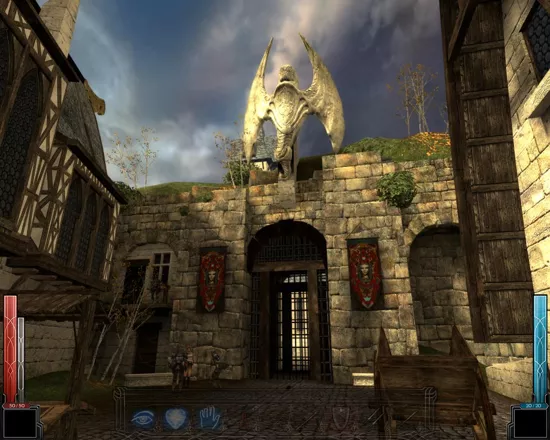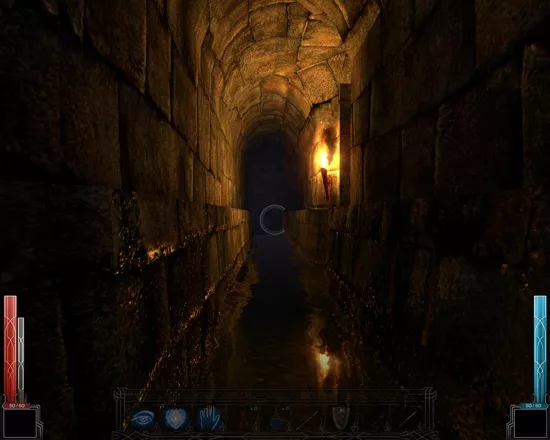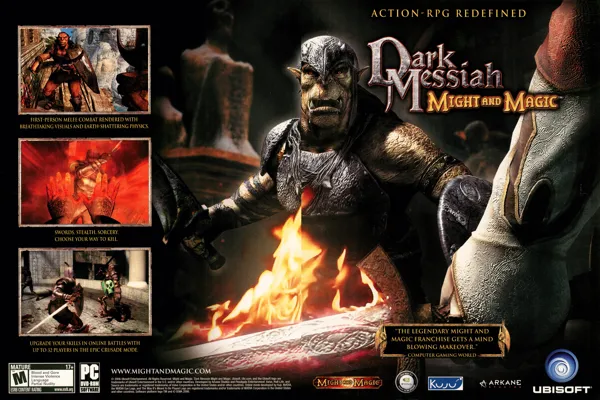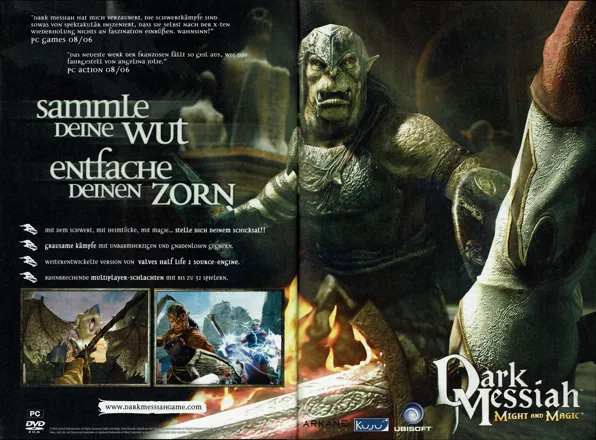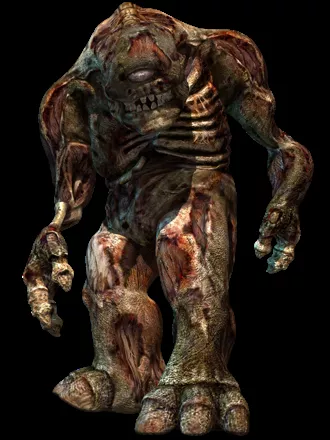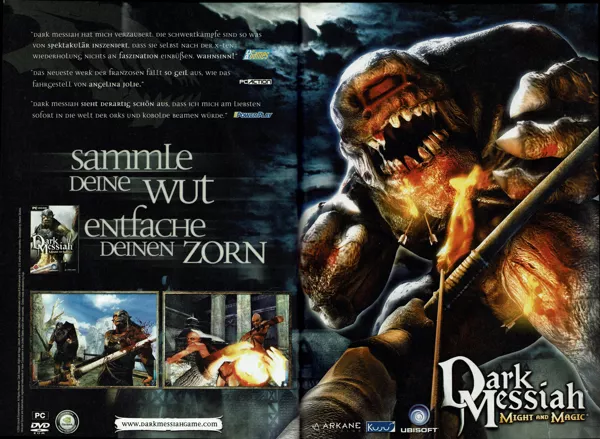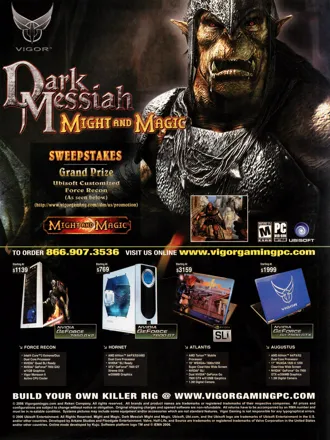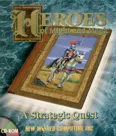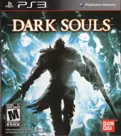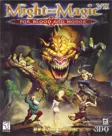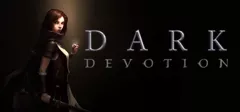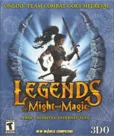Dark Messiah: Might and Magic
Description official descriptions
A long time ago an extreme powerful mage called the Seventh Dragon banished all demons from the world and paid with his death for this. But the prophecies tell that after a 1000 years, a Dark Messiah - half human, half demon - will return to the earth to destroy the barrier that stands between the worlds. Now twenty years ago, a Demon Lord successfully mates with Isabel, Queen of the Griffin Empire and all attempts of the Emperor to exorcist her fail (you can play this mission in Heroes of Might and Magic V) and the Dark Messiah is born. Also he doesn't know it yet, his goal is to obtain the Skull of the Seventh Dragon called Skull of Shadows from Skull Island, where it is guarded by the orcs and destroy the barrier between the worlds with it. The name of the Dark Messiah is Sareth and he's an mage apprentice. One day his master sends him to Stonehelm to help another mage retrieve the Skull. And so the Prophecy seems to become real. But it is yours to decide if you use the Skull, once you've obtained it, for good or for evil since you are playing Sareth.
Dark Messiah: Might and Magic is a first-person action game set in the medieval age so instead of guns you use swords, bows and magic to defeat your enemies. As you progress through the story you obtain skill points which you can invest in one of three skill trees called Combat, Magic and Stealth. How you skill Sareth directly influences the combat in the game. You can either play like an assassin and backstab your enemies to oblivion or make him a perfect sword-fighter who can use different combos to take out his enemies for example.
But you can also use your environment to make your kills. There're countless items you can lift up and throw at your enemy or you can light up your arrow on a campfire nearby to inflict more damage. You can also make good use of your foot and kick your enemies off cliffs or kick them into spikes that come out of the wall or use other traps that are scattered in the levels like bringing a statue to a fall.
The main innovation in Dark Messiah is the so-called Body Awareness System. This basically means that Sareth is a real part of the world like every other NPC. This makes not only the whole combat more intense because your whole body moves with every sword-swing you make but the NPCs can interact more directly with you. For example a Orc can take you by your neck and throw you through the room.
If you've already saved (or damned) the world you can turn to the multiplayer-mode. There you've access to five different character classes from the knight to the priestess. With each kill you make you earn experience points and increase in rank. Then you get skill points you can invest in your skill tree to get new talents or upgrade existing ones. This is most important in the Conquest game-mode in which you play various maps in a row and keep your level between all the way. In the Conquest-mode two teams (Humans and Undead) fight over the possession of the flags on a map. Once one team holds all flags, it wins and the next map is loaded. But there's also normal (Team-)Deathmatch available.
Spellings
- 魔法門黑暗彌賽亞中文版 - Traditional Chinese spelling
- 魔法门之黑暗弥赛亚 - Simplified Chinese spelling
- 다크 메시아 오브 마이트 앤 매직 - Korean spelling
Groups +
- 3D Engine: Source
- Fantasy creatures: Orcs
- Fantasy creatures: Succubi or incubi
- Fantasy creatures: Trolls
- Gameplay feature: Drowning
- Gameplay feature: Equipment quick slots
- Gameplay feature: Multiple endings
- Middleware: Bink Video
- Might and Magic universe
- Software Pyramide releases
- Sound Engine: AIL / Miles Sound System
- Technology: amBX
- Ubisoft eXclusive releases
- White Label releases
Screenshots
Promos
Videos
Add Trailer or Gameplay Video +1 point
See any errors or missing info for this game?
You can submit a correction, contribute trivia, add to a game group, add a related site or alternate title.
Credits (Windows version)
490 People (421 developers, 69 thanks) · View all
| President | |
| CEO | |
| Executive Director, Worldwide Studios | |
| Chief Creative Officer | |
| EMEA Director | |
| USA Director | |
| Director Third Party Development | |
| Executive Producer | |
| Producer | |
| Associate Producer | |
| Assistant Producers | |
| Business Development | |
| Marketing Game Manager | |
| Marketing Coordinator | |
| Special Thanks | |
| Creative Director | |
| Producer | |
| Lead Level Designer | |
| Lead Programmer | |
| Art Director | |
| Art Technical Expert | |
| Lead Animator | |
| Executive Producer | |
| Studio Manager | |
| [ full credits ] | |
Reviews
Critics
Average score: 76% (based on 50 ratings)
Players
Average score: 3.9 out of 5 (based on 75 ratings with 5 reviews)
Fantasy, epic, boredom, spectacle, boxes, barrels and tits
The Good
So you are fourteen, you got acne, you are male and you probably live in some Anglo Saxon, European or some ex-soviet country. You have played games since you can remember and 2D is a concept that you don't even understand. Then you browse through your favorite, flash loaded webs about videogames and, suddenly, you find some videos or screenshots of "Dark Messiah" and you think, "wow!, that is a cool game".
It's like an FPS, except that there are orcs and stuff. And look, there is even a dragon, too. My god!, look at those awesome spell animations, and you can impale your opponents! And you can cut ropes that trigger traps, that's amazing. You know what?, there is even magic. Certainly, your teenage tendency to associate action with sex is making your hormones act like kids asking their fathers for some stupid toy they saw on TV before Christmas.
In fact, this game is all about shock value (yes, there is even a lighting spell, too, :)). Finally, whoever holds rights for Might & Magic has realized that the best evolution possible for the franchise is to make an FPS, instead of another game of..., well, thinking. We all know that games are all about action and fans of the series has finally received what they wanted since the first M&M game was released, an FPS, the king of genres.
The Bad
Probably, if you actually are fourteen years old, you wont understand what the problem with this "cool" game is, but this is actually a very good example of the sickness the industry of videogames is experiencing since the late 90's. It's all about shock value and fast transactions of money from your pocket to the content producers' pockets. If you don't believe me, let's see what for are you paying the 40€ this game used to cost.
The game lasts around 12 hours, 8 of which are mostly iterations of the previous ones and as you may have guessed, you can watch most of those 4 hours in the promo videos.
There are, let me count..., no more than 15 different enemies in the whole game, and I'm counting the bosses too (I'm serious, I have counted them). Not only that, but, as they barely mix, you can expend a whole hour killing the same type of enemy all the time. And with the same type, I mean even with the same model and voice. Just because some orcs have bow and others don't, it doesn't make it funnier to kill the same orc 30 times in a row.
The scenarios are also very repetitive. There are like four types of them, and the cliffs from Skull Island (you know, the island where the skull is), which are slightly more interesting than the rest. These are temple, palace/house, city and, of course, the loved-by-all sewers. Necropolis could also be counted, but it's looks a lot like temple, but multiplying the number of tombs by two. When these are not enough, fire and ruins can make some of the previous look slightly different and sum up to the total 10 levels of the game, each of one less original and more tedious than the previous. You know when you start playing a game and it's very fresh and varied at the beginning, but when the part they showed at E3 is finished the game begins getting more and more repetitive? Well, Dark Messiah has it too.
As for now, this game doesn't look very worthy to me. This is just the usual fast-developed product that gives the videogame industry the property of industrial instead of artistic or cultural and makes the general public think on videogames as a form of entertainment instead of culture. You can see this on the average to low quality of all the artistic design on Dark Messiah. You have orcs, goblins, dragons, undeads, necromancers, spells of fire, of ice, of lighting, swords, staffs, bows, etc., and they all look like always. New is a missing concept here.
"What are those statues of big warriors in the temple scenarios for?", you can ask to the lead designer, "nothing, they looked cool and we add them to fill the place" he will answer you. "Ey!, how could I design an orcish sword?" could some object designer ask, "I don't know, look on the internet and copy the coolest looking one" would say the object lead designer. "We are designing a second model for the undeads right now" could the lead designer say, "no, one foe one model, we want to release the game as soon as possible to spare money on the production" would the production director respond. "...and then Leanna defeats the..." tells the story writer while explaining the story to the marketing director, "that's silly, make her just helpless and stupid..., and with big tits" he interrupts and "much better, make another secondary hot female character" he adds.
You can imagine this kind of conversations between unmotivated designers and impatient and money-thirsty producers. Seriously, just hear the dialogues of the porn actress that accompanies the main character, I'm playing the game again just to see if I can have sex with her (which I doubt). And how cleverly does she points you to the solution of every puzzle in the game. Just when you spend more than five seconds looking for the solution to a dead-end she tell something like “well, it looks like you should go to the well hidden panel in front of you, push red-white-red-blue buttons in that order, use the “iron key” in the keyhole at the right of the panel and say the magic orcish words I'm writing you phonetically in a note”. Phew!, you nearly needed to use your brain.
And technically, the game doesn't look that good either. Yes, graphics are more or less modern, but the whole design lacks motivation and it affects negatively the player very fast (as anything else in the game). As I said, models and textures are reused a million times in each level. Orcs looks like typical orcs, swords like typical swords, black knights like typical black knights and so on, and the animations are rather broken. Even the spells, that looks spectacular most of the time, have very unrealistic sounds (yes, spells are not real by themselves, but still...).
But the worst graphics feature in this game have to be the lighting. The lighting is not bad by itself, but level design makes it really painful for your eyes. Every time you are indoors lighting will be composed of low intensity but bright light sources scattered through the level. That means a continuous change in the light intensity of your screen which can make your eyes hurt in less than half an hour of playing session. The solution to this? The dark vision spell, that let's you see the world in a scale of purples that also gives you headache. And not happy with this, the spell designers decided to make your most powerful attack spell some kind of flamethrower that fills all the screen with yellow fire to make your already hurting eyes cry. If I say this game is painfully to play, I'm talking literally.
The only thing that can save this game is the combat system, based on using extensively the many traps the levels consist on and the many weapons and spells you can access to in the game. Still, this gets repetitive very fast, specially in the last levels, when you can kill hordes of enemies without even looking put interest in what you do. By the second or third level you start considering how lucrative it has to be to have a shop of spike traps.
Other not-too-bad feature is the simplified RPG system. Every time you finish a level or complete a task, you gain some skill points that can be spent increasing your abilities. Basically, you can be a thief, a mage or a warrior (now that's variety) or a mix of them. As any role player knows, mix are only good if the system is balanced and this is quite truth for Dark Messiah. The problem is that this game is very repetitive and changing your strategies all the time to make an effective use of all the skills of your warrior-mage, mage-thief or thief-warrior will only make it last longer. I played the game as a total warrior and a total mage, and by the half of the game it was so boring that I only wanted to finish it fast. If you choose a mixed role for your character the game will only take longer and more tedious, and I don't even want to imagine how is it to play it with a thief.
Other RPG element simplified for Dark Messiah is the inventory. I think there's nothing on this game that you can be called a "puzzle" so the inventory only stores thing that wont interact between them nor with thing the world outside the inventory. And it's so huge that, unless you want to collect it all, you wont have to choose carefully what to store and what not.
The Bottom Line
Ok, Dark Messiah is a spectacular game, with a lot of action, some interesting use of RPG and... more spectacle, but it is an ostensibly low quality product. You can feel it, is everywhere. All elements are repeated a gazillion times, everything looks like done before, the story is boring, the characters void, you know that even the producers and designers of the game don't give a crap about it. It's very hard to enjoy and take seriously a game under these circumstances. Don't get tricked by the trailers and cool screenshots, it doesn't worth it.
And who the hell is that guy in the main menu?
Windows · by MichaelPalin (1414) · 2007
Tries so Hard to Be Xtreme, Fails. At Everything Else Too.
The Good
There were times when the game’s graphics didn’t offend me. The Spiders the giant trolls and of course the Dragon. The Spider lair itself scared me pretty well, and when hoards of arachnids are tumbling down on you, you’ll appreciate the game. That’s about it.
Aside from that, the melee combat was entertaining for an hour, maybe. I enjoyed kicking people into spikes and whatnot, but only for that same first hour. Um, aside from that there isn’t much else to say. The water looked pretty good, I guess?
The Bad
There honestly isn’t much that I loved about Dark Messiah of Might and Magic. The acting, dialogue and story all made me cringe. Aside from the ludicrous and sexist portrayal of the demon temptress who you meet at the beginning of the game (trust me, you won’t believe how badly this character is implemented) the rest of the characters are more stereotyped than those of a bad Japanese RPG. The villains are always cackling and laughing up their sleeves, the good female character is there solely as a romantic interest, “hot” body and foil to the sexy demon temptress, and all other characters are secondary. I actually thought that the plot was interesting, but it was so muddled and badly organized that I quickly lost interest.
The combat, as mentioned before, gets old fast. You’ll quickly realize that you have to block and attack in a very regular fashion. Bows, magic and other supposedly cool abilities are largely unpleasant to use. Enemies are mundane when confronted as a fighter, and annoying when confronted as a spell caster or thief.
Returning to the presentation of the game, I liked some of the landscapes a bit, but the problem was how the Source engine was used. I know that this engine can create some amazing vistas, so why was it that every single wide-open area looked awful. Every other texture was so blurry it was like they were underwater. This applied to creatures and items too. The worst was when I realized that my sword was basically a grey stick that got a bit red when I stabbed people. The darker areas look pretty bad, and all of the enemies animate horribly. The later zombie encounters are maddening, as is the fact that you don’t get really good items until way too late in the game.
Multiplayer is a mess, and there aren’t really enough people playing to make you care about it.
The Bottom Line
I really wanted to like this game. It takes place in one of my favorite universes, and it boasted a visceral, melee-oriented look and feel. Sadly, when you have a melee-oriented game where the melee is awful, you might have a problem on your hands. This game annoys and frustrates at every turn, and its portrayal of women is childish and offensive. A few fun creature encounters and some clever set pieces can’t save this game from its own awful design. It doesn’t matter if you’re looking for a melee FPS, an action RPG, or any other swords and sorcery epic. Look somewhere else.
Windows · by Tom Cross (28) · 2008
An over-the-top fantasy shooter (sans guns)
The Good
In terms of visceral, face-to-face, first-person-combat, Dark Messiah has got the field licked.
Kicking opponents into fires, spikes, and over cliffs is endlessly amusing, if improbable.
Full frontal nudity in cutscenes are always a plus.
The Bad
Stability, stability, stability. Even on its latest patch, Dark Messiah tends to crash way more often than it should...and beware those of you who like to turn the settings knobs to 11.
Throwaway story and plot.
Some very tedious, go-through-the-motions gameplay in areas.
Uneven graphics -- some outdoor areas are particularly onerous.
Giant spiders ahoy! Somebody call the fantasy monsters union and complain.
Game overfavors "tank" melee characters. Don't expect to play Garrett or a pure mage here.
The Bottom Line
Might & Magic Dark Messiah is very easy to sum up: it’s a fantasy first-person-shooter where all of your good ranged weapons are taken away and replaced with melee weapons. It is most definitely not an RPG – while the game uses RPG-like elements, they are trivial and would have been better replaced with a streamlined shooter-style interface. For example, there’s an inventory screen…every RPG needs an inventory screen, right? However, you have enough slots to carry every portable object in the game, and since many objects are simple upgrades to earlier objects, why not just go for a simple “next-item-previous-item” interface?
Other RPG facades include the ability to upgrade your alter-ego with the use of skill points given to you throughout the game. You can buff up your character’s melee skills, stealth skills, or magic skills. Unfortunately, the game’s design focuses around the golden path of the tank. Enterprising sneaky types will be disappointed by the fact that enemies are able to unerringly locate you after one successful sneak attack, regardless of where you’re hiding (or the fact that you soaked up a ton of skill points in hiding skills). Magic users will be disappointed by the slow rate of fire of their offensive spells, since the enemy A.I. mainly consists of quickly getting into your character’s face.
Luckily, however, I like tanks, and I play them all the time. M&MDM is a wonderful fantasy tank simulator. The first-person melee combat is meaty and bloody. It rewards both the frantic button-masher as well as the more deliberate button-masher. Although many of the combat situations are implausible and suffer from “why is that guard standing next to a barrel of boom” syndrome, there’s a lot of mileage in being able to pound, kick, and smash enemies into fires, conveniently-placed spike traps, and over the edge of cliffs. Although some folks may prefer the trickier 3rd-person melee combat setup of games such as Jedi Outcast, I prefer straightforward bashing and smashing over spinning wall-leap maneuvers … but then again, I believe that if god wanted us to play shooters in 3rd person, he would have given us floating cameras in real life.
Surprisingly, the one trick that M&MDM does well is just enough to cover up the game’s myriad flaws. Stability is not the least of those flaws – the game is a RAM pig, and if the graphic settings are set just a smidgen too high for your system to handle, the game will crash all over the place. The old Source engine bugaboo of stuttering sound makes an annoying reappearance, as well. More downsides include a yawner of a background story (complete with a “plot twist” that can be spotted from a mile away), uneven graphics, and an ever-present NPC (whom I dubbed “Shodan” for reasons made obvious for any System Shock fan that plays this game) that ruins all of the game’s puzzles by telling you exactly what to do next. It should be noted, though, that you do get full-frontal nudity “Shodan” cutscenes, so that’s a plus, I suppose.
So, is the game worth $40? Probably not. The game is weak in every area but melee combat (in which it admittedly does well) and its few subtleties are shown far too early and used way too often. The incarnation of the Source engine used in this game struggles mightily and crashes frequently. The story, settings, and opponents are all generic throwaway quality (yes, you WILL fight giant spiders, that’s all that needs to be said). Still, this is a game where the overall experience somehow manages to lift itself from the sum of its component parts, and I had a surprisingly good time working my way through it. Wait until it hits the $20 price point, and it’s a decent, if totally forgettable buy.
Windows · by Chase Dahl (5) · 2007
Trivia
Development
This is the second Might & Magic since Ubisoft acquired the license to the universe. The singleplayer part of Dark Messiah was developed by Arkane Studios. Kuju Entertainment Ltd. was responsible for the multiplayer mode.
German version
In the German retail version, some blood effects were removed: when executing an enemy which lies on the ground, in cutscenes and during a special move against the enemy's stomach in adrenaline mode. Also removed were cut off limbs, enemies die instantly instead of slowly burning to death when using fire, and interactions with corpses (using weapons, burning, throwing). A detailed list of changes can be found on schnittberichte.com (German).
The German version on Steam is uncut.
Setting
Dark Messiah: Might and Magic takes place in Ashan, the Might & Magic world created by Ubisoft. It replaced the old Might & Magic universe, which consisted of many different worlds and was used by New World Computing until its dissolution. According to Ubisoft, it was done because the old continuity became hard to manage, and to avoid confusing newcomers.
In contrast with the old universe, which incorporated science fiction elements, Ashan is a pure fantasy world. The first game it was featured in was Heroes of Might and Magic V.
Awards
- GameStar (Germany)
- 1 February 2007 - Best PC Action Game in 2006
- PC Powerplay (Germany)
- Issue 02/2007 – #2 Best Action Game in 2006
- Issue 03/2007 – Best Action Game in 2006 (Readers' Vote)
Information also contributed by Mark Ennis.
Analytics
Identifiers +
Contribute
Are you familiar with this game? Help document and preserve this entry in video game history! If your contribution is approved, you will earn points and be credited as a contributor.
Contributors to this Entry
Game added by Sicarius.
Additional contributors: Unicorn Lynx, Sciere, vedder, Paulus18950, lee jun ho, Patrick Bregger, Plok, Stuttgart.
Game added November 18, 2006. Last modified January 16, 2025.


